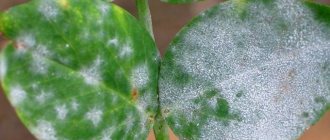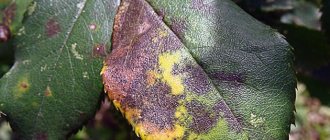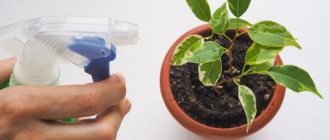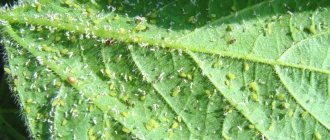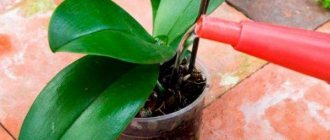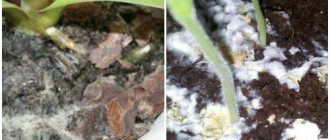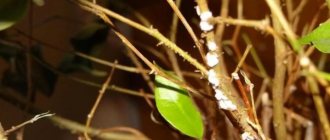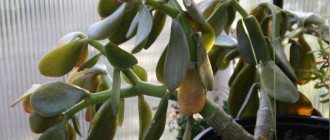Causes and symptoms of powdery mildew on house flowers
It is easy to identify the disease; it is enough to know what it looks like on house plants: leaf blades and stems are covered with voluminous white spots. Externally, the flower looks as if flour was spilled on it. These are parasitic spores that, after maturation, secrete droplets of liquid similar to dew.
At the initial stages of the development of the disease, fungal spores are mistaken for ordinary dust and they simply try to wipe it off. But this measure does not help.
The raid is growing again. First, the basal leaves on the outer and back sides are affected, then the remaining parts of the plant, including stems, flowers and buds, become covered with white spots with jagged edges. Over time, the spots turn brown.
Dormant spores are often present in the soil. Under certain conditions, they wake up and begin active life.
Causes of powdery mildew on indoor flowers:
- Improper watering, both excessive and insufficient.
- Too frequent and abundant spraying, after which drops of moisture remain on the leaves.
- Excessive density of plantings.
- Weakness of indoor plants as a result of damage by insects, other diseases, and improper care.
- Lack of potassium in the soil.
- Excess nitrogen.
- High humidity in the room – above 60%.
- Very high air temperature – +25 °C and above.
- Contact with infected plants through humans, insects, drafts.
- Unfiltered water for irrigation.
Causes
Ashpelt appears due to many factors:
- Cool weather (+15-25 degrees), excessive humidity 60-80%, rainy season. Weather conditions affect street and balcony seedlings the most.
- The soil is oversaturated with nitrogen.
- The seedlings are planted too densely.
- The hydration regime is disrupted. Excessive or infrequent watering are sure prerequisites for a decrease in the seedling's immunity and the appearance of flour.
To avoid plant infection, the above mistakes in care and cultivation should be corrected.
Why is powdery mildew dangerous?
Up to 60% of affected plants die. Harmful spores spread very easily, and the disease is difficult to treat.
Here are just some of the consequences of powdery mildew:
- The process of photosynthesis is hampered, causing the plant as a whole to suffer.
- Lack of nutrients.
- Slow growth.
- Inhibition of flowering.
- Dying of leaves and buds.
Very often, decorative flowering indoor plants with large flowers and leaves, such as gerbera, violet, chrysanthemum, etc., suffer from this disease.
It is necessary to distinguish true powdery mildew from downy mildew (downy mildew). They look almost the same. With downy mildew, only the back side of the leaf is covered with bloom.
Downy mildew
Very soon it turns yellow and then brown. The methods of dealing with them are different.
Symptoms
Light spots called powdery mildew appear on the outside and inside of the leaf blade; not everyone knows how to deal with the disease. If you try to erase the stains, they will disappear, but will appear again in the same place. Over time, they increase in size and become gray.
The disease manifests itself in the lower part of the plant, gradually reaching the upper leaves.
Important!
Most often, fungi appear in May-June.
When the spores have already affected a significant part of the shoots, the spots turn brown. The exhausted leaves begin to dry out. The inflorescences fall off. Growth and development stops, the formation of inflorescences stops.
As a result, the flower is not able to regulate photosynthesis, becomes deformed and loses its decorative effect.
Fighting powdery mildew on indoor plants at home: means and methods
A diseased flower becomes a carrier of infection, so immediately after detecting symptoms of powdery mildew, the pot or flowerpot with the flower must be isolated and contact with other indoor plants in the room limited, otherwise the disease can quickly spread.
For the same reason, purchased or donated indoor flowers should be kept in quarantine for up to 10 days.
Immediately before treatment and during the procedures, the regime of plant maintenance should be changed. To do this, observe the following rules:
- Remove all affected leaves, buds, and stems. Also tear off the lower leaves and branches that are in direct contact with the ground.
- Remove the top of the soil and replace it with new one.
- Thoroughly wash and disinfect the tray or flowerpot used to collect excess moisture when watering.
- Reduce watering and do not spray the plant while using medications.
- Do not use fertilizer. If the disease is successfully completed, subsequently, for the purpose of prevention, abandon nitrogen fertilizers, replacing them with phosphorus-potassium fertilizers.
- It is better to choose a place to keep the plant in quarantine that is well lit, but not hot and ventilated.
Different remedies for powdery mildew are used on houseplants:
- chemical;
- biological;
- folk
Avoid high humidity
Placement on stands filled with water with pebbles has a beneficial effect on plants. This creates a microclimate favorable for plant growth and maintains their health in good condition. However, excessively high air humidity is an ideal condition for the development of powdery mildew. Therefore, it is recommended to inspect the plants, and if signs of damage appear, reduce air humidity, improve air circulation and maintain constant soil moisture.
Folk remedies in the fight against powdery mildew
Folk remedies are available, can be found in almost every home and will not cause any harm. They can also be used for preventive purposes. Several recipes for spray mixtures:
Ash + soap
Take 100 g of sifted wood ash per liter of warm water. Stir and leave for about a week, shaking occasionally. After the expiration date, the liquid is drained, being careful not to raise sediment. Add 50 g of laundry soap shavings to it, wait until completely dissolved. You can use liquid soap. The plant is sprayed with this solution every day for a week.
Copper sulfate + soap
50 g of soap, prepared in the same way as in the previous recipe, is dissolved in 5 liters of warm water. Separately, stir copper sulfate powder (5 g) in a glass of water (250 g). Gradually pour into the soap solution in a thin stream. Spray damaged flowers every other day until the symptoms of powdery mildew disappear.
Mustard
Stir mustard powder (2 level tablespoons) in 10 liters of water. After a day, the infusion is ready. They can be used to water the soil and spray the above-ground parts of the plant. It is better to alternate both for 10 days.
Milk
You will need sour milk, yogurt, or even better, whey. Dilute with water in a ratio of 1:3 and treat plaque on indoor plants once every three days for two weeks. This method is good because the solution can be used immediately without insisting, and you can always prepare a new portion.
How to use fungicides and biofungicides?
Timely and correct use of chemical measures against ashtray is effective. Chemicals are sold in specialized stores and their prices are quite low. For convenience, sprayers are used. When working, it is recommended to follow safety precautions: carry out the procedure in a respirator and gloves.
The most commonly used fungicides are:
- Copper sulfate. Only one treatment is possible per season - in early spring. To prepare the mixture, 50 grams of the substance are diluted in 10 liters of water. To prepare the most effective product, add 35 grams of vitriol to 500 ml of boiling water, and separately stir 150-200 grams of soap shavings into 10 liters. Then slowly and carefully pour the resulting liquid into the soap substrate, stirring constantly.
- Tiovid Jet. Purchased for the treatment of pears, apple trees, cucumbers, and grapes.
- Fundazol. Unfortunately, it is not sold in small packaging; it is produced in bags from 5 to 20 kg. It is recommended to spill the soil, especially for infected violets.
- Topaz. Produced for the prevention and treatment of flour.
- Colloidal sulfur. Suitable for processing different types of crops, shrubs and trees. A special difference between this fungicide and others is that it can be sprayed 3 days before harvest. But it is not recommended to spray sulfur on gooseberries. Be careful with watermelons, zucchini, melons, cucumbers and pumpkins, as these plants do not tolerate the effects of sulfur well. Spray strictly at an air temperature of +27-32 degrees, otherwise there will be no effect.
- Also popular are Zato, Forecast, Topsin-M, Tilt and Quadris.
Biofungicides contain live bacteria that can eliminate the development of infection that accumulates on plants.
Biofungicides are environmentally friendly, so they are used even during crop ripening. Their effectiveness is lower than when using chemicals - their effect does not last long. They should be used repeatedly. The most commonly used are Fitosporin, Pseudobacterin-2 and Alirin-B.
Biological products for powdery mildew on indoor plants
Biological drugs are less effective than chemical ones. But they are less harmful. They are safe both for the flower itself and for humans and everyone who has contact with the plant.
Their action is based on living bacteria that naturally fight the mycelium of the fungus, suppressing and inhibiting it.
The most common and accessible drugs are: Fitosporin, Alirin, Gamair, etc.
Use strictly in accordance with the instructions. To achieve a lasting result, treatment with biological products must be repeated several times.
Biological treatments
Everything in nature is balanced. Scientists have found that there are strains of the bacteria Baccillus Subtilis, which the fungus described is happy to destroy. Biological products have been developed that kill parasitic mycelium:
- Fitosporin - it successfully treats soil and plants during the growing season;
- Gamair - 1 tablet is dissolved in 5 liters of water and mixed with soapy water before applying to the root;
- Alirin - used for watering;
- Baktofit - used to treat the upper part of the plant and irrigate the roots.
These biological agents are less effective than chemicals, but are absolutely harmless to animals and humans. Even insects do not suffer from them.
Important! Biological products have certain expiration dates and storage conditions. They cannot be saved for a long time. The effectiveness decreases over time as the bacteria die.
After using such products, it is advisable to refrain from spraying the plant for some period, since water quickly washes away the preparations.
Chemicals against powdery mildew at home
The harmful effects of fungicidal (chemical) drugs are well known. They are resorted to only in extreme cases, when the disease is very advanced, but you don’t want to lose a particularly valuable specimen from your home collection.
To avoid harm when using toxic products, you need to carefully study the recommendations for the application and use of personal safety measures.
At home it is allowed to use: Topaz, Fundazol, Vitaros, etc.
Complex use of different means
The most noticeable effect comes from the combined use of various means. The fight must be waged on all fronts.
Severely damaged plants are treated with fungicides. The effect is secured with biological products. And for prevention they use folk recipes.
It is important to use gloves and even special clothing for any contact with a diseased plant. Otherwise, the florist himself risks becoming a carrier of spores of harmful mycelium if, after contact with an affected flower, he touches healthy plants.
Use of fungicides
Chemical measures to combat powdery mildew, when used in a timely and correct manner, are quite effective.
Fungicides (fungus - fungus and caedo - kill) are chemicals used to combat fungal diseases of plants.
Of the modern fungicides against powdery mildew, it is worth noting the following drugs: Bayleton, Zato, Quadris, Rayok, Skor, Tilt, Topaz, Topsin, Tiovit Jet, Fundazim, Fundazol.
There have been cases of the emergence of fungal races resistant to chemicals on some crops, so the development of varieties resistant to powdery mildew is an extremely pressing issue.
Mr. Summer Resident informs: prevention of powdery mildew on indoor plants
Getting rid of powdery mildew is not easy, so it is easier to pay more attention to preventive measures. Simple tips will protect plants from other diseases and insect parasites.
- Spray as a warning with a solution of potassium permanganate (potassium permanganate) or sulfur. They are sold in regular pharmacies. This procedure is especially important during warm periods and long daylight hours, namely from May to September. One such spraying per month is enough to keep the plants protected.
- At risk are indoor flowers in a stuffy room or, conversely, standing in a draft. It is necessary to create comfortable conditions for green pets so that they are healthy.
- Avoid too humid a climate, which may occur on the balcony during prolonged rains or with the onset of cold weather. Avoid overwatering or drying out the soil.
- Remove wilted leaves and flowers in a timely manner to prevent rotting.
- Prevent the appearance of scale insects and aphids. They are carriers of other diseases and weaken plant immunity.
For the same reason, do not use soil taken from summer cottages, humus, or purchased soil without heat treatment. They may be infected.
Prevention
The development of powdery mildew is caused by high air humidity, poor air circulation and dry soil. It is very important to maintain a certain distance between plants. Regular ventilation helps reduce air humidity around the stems, leaves and flowers. Regularly monitor the soil moisture level; do not forget that drying it out creates favorable conditions for the development of fungus. As an additional remedy, use preventive spraying with a systemic fungicide.
Application of biofungicides
Biological agents such as biofungicides are used to protect plants from fungal diseases. They contain live bacterial cultures that can suppress the proliferation of pathogenic fungi.
Due to the fact that these drugs are safe from an environmental point of view, they can be used not only during flowering, but also during the period of fruit ripening. However, they are less effective than fungicides, and therefore plants must be treated quite often.
Thus, in the fight against this disease, it is recommended to use the following fungicides: Alirin-B, Pseudobacterin-2, Fitosporin-M, Gamair, and Planriz.

